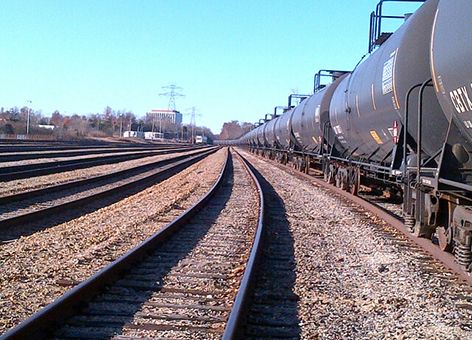As New Risks Emerge in Producing and Transporting Oil, University of Washington Helps NOAA Plan for Spills
This is a guest post by the Emerging Risks Workgroup at the University of Washington in Seattle.
JANUARY 31, 2014 -- From fracking to oil trains, the landscape of oil production and transportation in North America has been undergoing a major transformation in recent years.
This transformation has implications for how NOAA's Office of Response and Restoration prepares its scientific toolbox for dealing with oil spills. A group of graduate students from the University of Washington is trying to provide NOAA with a picture of new or emerging risks that oil spill response plans need to adapt to.
To do this, they first have to look at what is causing the risks of transporting oil and gas products to change over time. They then compare those changes to changes that have already been accounted for by spill response planning. Once these "emerging" risks are accounted for, they can list in detail those areas that are going to be areas of concern for NOAA in the future.
Fracking
The main drivers of change for spill risks are the changes in the production of crude oil and natural gas. By far, the largest change in the market is the proliferation of hydraulic fracturing or "fracking," which involves forcing fluids under great pressure through production wells to "fracture" rock formations to allow more crude oil or natural gas to be released. This controversial drilling technique has seen rapid and abundant growth in North America.
Fracking and other new technologies have resulted in a change in the types of petroleum products being transported in the U.S. It has changed where the products are originating, the quantities involved, and the methods of transportation.
LNG
Liquefied Natural Gas (LNG) is natural gas that has been cooled to -260° Fahrenheit and liquefied for ease of transport. Its production has substantially increased in recent years. This is a result of the lower prices for natural gas that are caused by the immense supply, which is in turn due to increased production from fracking. Because there is so much LNG available at lower prices, two major changes in natural gas transportation have occurred.
First, due to the immense volume of available LNG (and the lack of export bans), the U.S. has started to export more LNG than in the past. The biggest recent change in LNG transport is the more widespread adoption of the LNG tanker. These tankers are just what the name implies: tanker ships storing large quantities of refrigerated LNG. These massive LNG tankers create a myriad of new challenges due to the nature of LNG (it is highly flammable) and the locations of shipping ports, which need to be large enough and properly equipped to load them.
Second, LNG is gaining popularity as a fuel for ships. Many of the new ships shipping companies are purchasing are built to run on LNG as well as traditional bunker fuel. Additionally, a number of existing ships are being retrofitted to run on LNG in certain conditions. As a result, fueling stations at the ports that service these large ships have to add a new fuel type that must be transported to the port and stored before fueling ships. This also further complicates port safety by adding more fueling processes that must be supported at in-port fueling stations.
Oil by Rail
Fracking, as well as the advances in producing oil from oil sands, has changed where crude oil is being produced. Because pipelines require more permits and are slower and more expensive to build, maintain, and operate than rail, there has been a large increase in transporting oil via rail cars. These "rolling pipelines" are a convenient use of existing transportation infrastructure but cause significant changes in the risks of transporting crude oil in the U.S.
Many of these rail lines, at times, run adjacent to navigable waterways and end at a port for export, which means spills from derailments may sometimes release crude oil into waterways. North America has already seen an increase in train derailments and resulting oil spills in recent weeks. This new risk is likely to grow, as the amount of oil transported by rail continues to grow each year.
Project Details and Timeline
The University of Washington research group will be finishing their research and report in the coming weeks. They plan on presenting the findings to NOAA's Office of Response and Restoration in mid-March and will also be presenting at a symposium for the University of Washington's Program on the Environment.
If you have any questions about the ERW, its members, their research, or would like to read any of their scoping documents, memos, or (eventually) the final paper, please visit their website at www.erw.comuv.com.
The Emerging Risks Workgroup (ERW) is a group of four graduate students from the University of Washington that are working with faculty advisor Robert Pavia and Doug Helton, the Incident Operations Coordinator for NOAA’s Office of Response and Restoration. The students in the group are all part of the Environmental Management Certificate Program at UW's Program on the Environment. Stacey Crecy is from the School of Marine and Environmental Affairs and Andrew Cronholm, Barry Hershly, and Marie Novak are all from the Evans School of Public Affairs.
The views expressed in this post reflect those of the authors and do not necessarily reflect the official views of the National Oceanic and Atmospheric Administration (NOAA) or the federal government.
 An official website of the United States government.
An official website of the United States government. 

